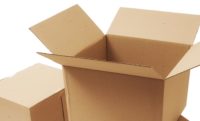Fibre Box Association Column
Engineering Boxes for Relative Humidity in the Distribution Environment




The ability to custom design corrugated packaging for specific use underlies its versatility and performance in a wide variety of product and distribution scenarios. To design and engineer an efficient and cost-effective package, it is important to understand the package performance requirements of the environment. Detailed knowledge of the specific distribution environment allows design and qualification of the package, speeding up both development and performance assurance processes.
Distribution Environment and Container Performance
The use of environmental factors to determine corrugated packaging strength requirements is a fundamental necessity. It allows engineers to establish safety factors for corrugated packaging to withstand top to bottom compressive loads in the environments that the packaging will be exposed to, such as the distribution and warehouse conditions. To date, the equations used to calculate these safety factors have been based on data derived in the 1960s and ’70s, using commercially available substrates of that era. The values are published in the
Fibre Box Association’s “Fibre Box Handbook,” which is used by corrugated packaging designers as a key technical resource.
Major advances in papermaking technology have been made since that time. Modern substrates are significantly different, with variations in furnish, fiber orientation and improvements in manufacturing technology. Recognizing significant value in revisiting the fundamental mechanics used in the calculations to account for these advancements, the corrugated industry commissioned research and is developing new guidelines that will be ratified and published this June. For the first time, recommended compression strength adjustments for relative humidity will be predicated not on calculated estimates, but on material testing of boxes made with today’s advanced machinery.
The purpose of the technical research project was to systematically examine the details of corrugated industry assumptions about the effect of moisture content on the top to bottom compression of average boxes in the marketplace today. The goal was to either validate or correct the environmental factors (published in the mid-1990s) that are used as a basis for box design in calculating and achieving the box customers’ top to bottom compression needs, as driven by relative humidity.
New recommendations will be made, based on laboratory testing of 3,000 boxes in controlled environments with relative humidity levels from 30 to 90 percent. The testing measured changes in box performance of 30 different marketplace-average boxes, each under the range of seven specified conditions, and provided quantifiable data for calculating new guidelines for compression strength requirements based on this real-world experience.
The net result of this research is very good news for the packaging industry: It has been proven that for most environmental conditions, stronger corrugated boxes can be produced with less raw material without compromising performance. Even the most humid environments may only compel environmental factors almost as high as the past factors. Bottom line? Better boxes can be made more economically even as raw material usage is reduced, supporting sustainability goals. New specification guidelines will be available from the Fibre Box Association.
To learn more, email info@fibrebox.org.
Looking for a reprint of this article?
From high-res PDFs to custom plaques, order your copy today!









